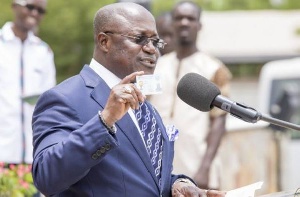 Executive Secretary of National Identification Authority (NIA), Prof Ken Attafuah
Executive Secretary of National Identification Authority (NIA), Prof Ken Attafuah
The National Identification Authority (NIA), led by Executive Secretary Prof Ken Attafuah, has clarified that the total cost of producing the Ghana Cards is $293 million, not $1.
The National Identification Authority (NIA), led by Executive Secretary Prof Ken Attafuah, has clarified that the total cost of producing the Ghana Cards is $293 million, not $1.2 billion, as widely reported.
In a statement released by NIA’s Corporate Affairs Department, the Authority said: “The NIS project to deliver ID cards to all Ghanaians is over a period of one year. Within this period, the state is committed to $124m while the project partner is committed to $169m.
“The total project cost for the delivery of the Ghana cards is, therefore, $293m and not 1.2bn USD. This total is expected to cover the technical and operational cost that will deliver ID Cards to all Ghanaians over the one year period”, the statement, which is produced in full below stated.
NATIONAL IDENTIFICATION AUTHORITY
NIA Reponses to Frequently Asked Questions on the Cost of the NIS Project
30th May, 2018
1. Why 1.2bn USD?
Answer
The NIS project to deliver ID cards to all Ghanaians is over a period of one year. Within this period, the state is committed to $124m while the project partner is committed to $169m. The total project cost for the delivery of the Ghana cards is therefore $293m and not 1.2bn USD. This total is expected to cover the technical and operational cost that will deliver ID Cards to all Ghanaians over the one year period.
When the card has been delivered and become fully functional, part of the revenues that NIA will be raking in by virtue of the daily use of the card, will be used to manage NIA’s operational cost and pay off the investments that the partners would make over a period of 15years. This is projected to be 1.2bn USD over the life-cycle of the project.
2. Who is paying?
Answer
The NIS project cost (one year within which cards will be delivered to all Ghanaians) will be borne by government and the partner.
3. How are we paying?
Answer
Government pays its part of $124m (the only cost the state will incur) through the consolidated fund as provided for in the 2017 budget. The partner pays off its part through a combination of loans and equity.
4. How many cards will be issued over the 15 year period?
Answer
A total of 90,823,235 cards will be issued. The breakdown is as follows:
Age 0-14
Age 15
Issued Abroad
Mass Issuance----------------9,160,850
New Issuance-----------------12,234,00
First Issuance0-14------------21,394851
Expiry replacement--------11,624,400
Replacement of lost--------4,145,450
Total Issuance---------------37,164,701
M. Issuance------15,418,774
N. Issuance-------10,835,353
F. Issuance-------26,254,127
E. Replacement--17,235,425
L. Replacement--8,756,454
Total Issuance---52,246,006
N. issuance---------596,000
E.Replacement----566,200
Total Issued------1,412,520
5. What Procurement methods were used?
Answer
A Public Private Partnership arrangement that comes with the requirements of Built, Maintain, Operate and Transfer. The contract terms and pricing are consistent with the Foreigner Identity Management System (FIMS) Pilot Project agreement executed between NIA and IMS in 2012, and the Feasibility Study Report for the present expanded project, which received two approvals by the Public Private Partnership Agreement Committee (PPPC) of Ministry of Finance in 2014 prior to the 2018 Final Approval.
These costs have undergone Value-For-Money (VFM) audits by the Public Procurement Authority (PPA) and have also been thoroughly assessed by the Public Investments Division of the Ministry of Finance. The contract has also been reviewed by the Attorney-General?s Department and the Legal Unit of the Ministry of Finance, as well as the Economic Management Team of Government. It has also received Cabinet approval. Copies of the Contract were distributed to all 275 members of Parliament, and appropriate waivers for import duty exemptions were also granted by Parliament.
6. What kind of cards?
Answer
Two types of cards will be issued:
2D Barcodes
This type of cards will be issued to children under 15years. Reasons;
Children within this age bracket will often not carry out transactions requiring the use of smart cards.
It will not make economic sense to issue smart cards to children within this bracket. The Authority currently has in stock 12million 2D Barcodes. In order that this stock is not wasted, which will amount to financial loss to the State, together with all the reasons for a 2D Barcode the Authority deemed prudent to issue 2D Barcode to citizens within bracket. Smart card.
All citizens 15 and above will be issued smart ID cards. Features of the smartcard include:
Meet all international quality standards of a smart card (International Civil Aviation Organization (ICAO), and International Organization for Standardization (ISO)) Has a 148kilobites space with 14applets that can host ID information or data for other state agencies (DVLA, SSNIT, NHIA, etc.)
Can be used in contact and contactless mode.
An e-Passport profile and application on the card that allow immediate travel across the ECOWAS sub-region without the need for a paper passport.
A Public Key Infrastructure (PKI) that protects our data and the ecosystem from unauthorised access
7. How interoperable will the cards be?
Answer
The NIA has a standing MOU with the Telecos, and they have agreed to integrate aspects of the NIA database relevant to them into their systems. The NIA database will be required for ID purposes in order to eliminate fraud on the interoperability platform.
Released by Corporate Affairs Department, National Identification Authority.